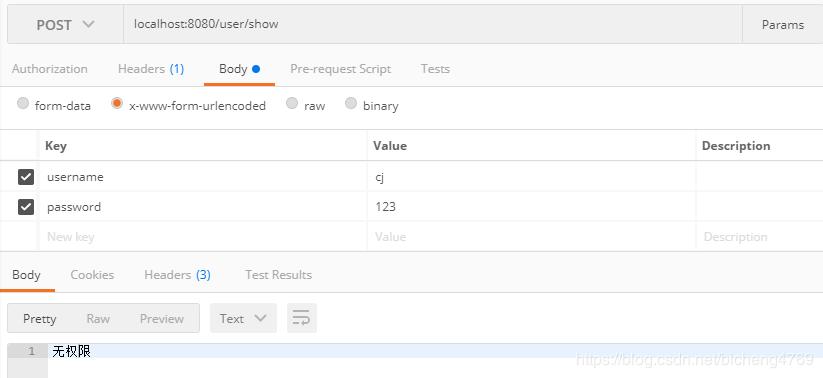SpringBoot--集成Shiro
Posted 11014p
tags:
篇首语:本文由小常识网(cha138.com)小编为大家整理,主要介绍了SpringBoot--集成Shiro相关的知识,希望对你有一定的参考价值。
转:https://blog.csdn.net/bicheng4769/article/details/86668209
什么是Shiro?
Apache Shiro是Java的一个安全框架,旨在简化身份验证和授权。Shiro在JavaSE和JavaEE项目中都可以使用。它主要用来处理身份认证,授权,企业会话管理和加密等。
Shrio使用有什么优点?
(1)身份认证/登录,验证用户是不是拥有相应的身份;
(2)授权,即权限验证,验证某个已认证的用户是否拥有某个权限;即判断用户是否能做事情,常见的如:验证某个用户是否拥有某个角色。或者细粒度的验证某个用户对某个资源是否具有某个权限;
(3)会话管理,即用户登录后就是一次会话,在没有退出之前,它的所有信息都在会话中;会话可以是普通JavaSE环境的,也可以是如Web环境的;
(4)加密,保护数据的安全性,如密码加密存储到数据库,而不是明文存储;
(5)Web支持,可以非常容易的集成到Web环境;
Caching:缓存,比如用户登录后,其用户信息、拥有的角色/权限不必每次去查,这样可以提高效率;
(6)shiro支持多线程应用的并发验证,即如在一个线程中开启另一个线程,能把权限自动传播过去;
(7)提供测试支持;
(8)允许一个用户假装为另一个用户(如果他们允许)的身份进行访问;
(9)记住我,这个是非常常见的功能,即一次登录后,下次再来的话不用登录了。
Shiro集成
-
引入maven依赖包
<dependency> <groupId>org.apache.shiro</groupId> <artifactId>shiro-spring</artifactId> <version>1.3.2</version> </dependency>
-
ShiroConfig类:对shiro的一些配置,相当于之前的xml配置。包括:过滤的文件和权限,密码加密的算法,其用注解等相关功能。
import org.apache.shiro.authc.credential.HashedCredentialsMatcher; import org.apache.shiro.mgt.DefaultSecurityManager; import org.apache.shiro.mgt.SecurityManager; import org.apache.shiro.spring.LifecycleBeanPostProcessor; import org.apache.shiro.spring.security.interceptor.AuthorizationAttributeSourceAdvisor; import org.apache.shiro.spring.web.ShiroFilterFactoryBean; import org.apache.shiro.web.mgt.DefaultWebSecurityManager; import org.springframework.aop.framework.autoproxy.DefaultAdvisorAutoProxyCreator; import org.springframework.beans.factory.annotation.Autowired; import org.springframework.context.annotation.Bean; import org.springframework.context.annotation.Configuration; import org.springframework.context.annotation.DependsOn; import java.util.LinkedHashMap; import java.util.Map; @Configuration public class ShiroConfig { @Bean(name = "shiroFilter") public ShiroFilterFactoryBean shiroFilter(SecurityManager securityManager) { ShiroFilterFactoryBean shiroFilterFactoryBean = new ShiroFilterFactoryBean(); shiroFilterFactoryBean.setSecurityManager(securityManager); shiroFilterFactoryBean.setLoginUrl("/login"); shiroFilterFactoryBean.setUnauthorizedUrl("/notRole"); Map<String, String> filterChainDefinitionMap = new LinkedHashMap<>(); // <!-- authc:所有url都必须认证通过才可以访问; anon:所有url都都可以匿名访问--> filterChainDefinitionMap.put("/webjars/**", "anon"); filterChainDefinitionMap.put("/login", "anon"); filterChainDefinitionMap.put("/", "anon"); filterChainDefinitionMap.put("/front/**", "anon"); filterChainDefinitionMap.put("/api/**", "anon"); filterChainDefinitionMap.put("/admin/**", "authc"); filterChainDefinitionMap.put("/user/**", "authc"); //主要这行代码必须放在所有权限设置的最后,不然会导致所有 url 都被拦截 剩余的都需要认证 filterChainDefinitionMap.put("/**", "authc"); shiroFilterFactoryBean.setFilterChainDefinitionMap(filterChainDefinitionMap); return shiroFilterFactoryBean; } @Bean public SecurityManager securityManager() { DefaultWebSecurityManager defaultSecurityManager = new DefaultWebSecurityManager(); defaultSecurityManager.setRealm(customRealm()); return defaultSecurityManager; } @Bean public CustomRealm customRealm() { CustomRealm customRealm = new CustomRealm(); return customRealm; } }
shiroConfig 也不复杂,基本就三个方法。再说这三个方法之前,我想给大家说一下shiro的三个核心概念:
Subject: 代表当前正在执行操作的用户,但Subject代表的可以是人,也可以是任何第三方系统帐号。当然每个subject实例都会被绑定到SercurityManger上。
SecurityManger:SecurityManager是Shiro核心,主要协调Shiro内部的各种安全组件,这个我们不需要太关注,只需要知道可以设置自定的Realm。
Realm:用户数据和Shiro数据交互的桥梁。比如需要用户身份认证、权限认证。都是需要通过Realm来读取数据。
shiroFilter方法:
这个方法看名字就知道了:shiro的过滤器,可以设置登录页面(setLoginUrl)、权限不足跳转页面(setUnauthorizedUrl)、具体某些页面的权限控制或者身份认证。
注意:这里是需要设置SecurityManager(setSecurityManager)。
默认的过滤器还有:anno、authc、authcBasic、logout、noSessionCreation、perms、port、rest、roles、ssl、user过滤器。
具体的大家可以查看package org.apache.shiro.web.filter.mgt.DefaultFilter。这个类,常用的也就authc、anno。
securityManager 方法:
查看源码可以知道 securityManager是一个接口类,我们可以看下它的实现类:
具体怎么实现的,感兴趣的同学可以看下。由于项目是一个web项目,所以我们使用的是DefaultWebSecurityManager ,然后设置自己的Realm。
CustomRealm 方法:
将 customRealm的实例化交给spring去管理,当然这里也可以利用注解的方式去注入。
-
CustomRealm类:自定义的CustomRealm继承
AuthorizingRealm。并且重写父类中的doGetAuthorizationInfo(权限相关)、doGetAuthenticationInfo(身份认证)这两个方法
import org.apache.shiro.SecurityUtils; import org.apache.shiro.authc.*; import org.apache.shiro.authz.AuthorizationInfo; import org.apache.shiro.authz.SimpleAuthorizationInfo; import org.apache.shiro.realm.AuthorizingRealm; import org.apache.shiro.subject.PrincipalCollection; import org.apache.shiro.util.ByteSource; import org.springframework.context.annotation.Bean; import org.springframework.context.annotation.Configuration; import org.springframework.stereotype.Component; import java.util.HashSet; import java.util.Set; public class CustomRealm extends AuthorizingRealm { @Override protected AuthorizationInfo doGetAuthorizationInfo(PrincipalCollection principalCollection) { String username = (String) SecurityUtils.getSubject().getPrincipal(); SimpleAuthorizationInfo info = new SimpleAuthorizationInfo(); Set<String> stringSet = new HashSet<>(); stringSet.add("user:show"); stringSet.add("user:admin"); info.setStringPermissions(stringSet); return info; } /** * 这里可以注入userService,为了方便演示,我就写死了帐号了密码 * private UserService userService; * <p> * 获取即将需要认证的信息 */ @Override protected AuthenticationInfo doGetAuthenticationInfo(AuthenticationToken authenticationToken) throws AuthenticationException { System.out.println("-------身份认证方法--------"); String userName = (String) authenticationToken.getPrincipal(); String userPwd = new String((char[]) authenticationToken.getCredentials()); //根据用户名从数据库获取密码 String password = "123"; if (userName == null) { throw new AccountException("用户名不正确"); } else if (!userPwd.equals(password )) { throw new AccountException("密码不正确"); } return new SimpleAuthenticationInfo(userName, password,getName()); } }
自定义的Realm类继承AuthorizingRealm类,并且重载doGetAuthorizationInfo和doGetAuthenticationInfo两个方法。
doGetAuthorizationInfo: 权限认证,即登录过后,每个身份不一定,对应的所能看的页面也不一样。
doGetAuthenticationInfo:身份认证。即登录通过账号和密码验证登陆人的身份信息。
controller类:
@RequestMapping(value = "/login", method = RequestMethod.GET) @ResponseBody public String defaultLogin() { return "首页"; } @RequestMapping(value = "/login", method = RequestMethod.POST) @ResponseBody public String login(@RequestParam("username") String username, @RequestParam("password") String password) { // 从SecurityUtils里边创建一个 subject Subject subject = SecurityUtils.getSubject(); // 在认证提交前准备 token(令牌) UsernamePasswordToken token = new UsernamePasswordToken(username, password); // 执行认证登陆 try { subject.login(token); } catch (UnknownAccountException uae) { return "未知账户"; } catch (IncorrectCredentialsException ice) { return "密码不正确"; } catch (LockedAccountException lae) { return "账户已锁定"; } catch (ExcessiveAttemptsException eae) { return "用户名或密码错误次数过多"; } catch (AuthenticationException ae) { return "用户名或密码不正确!"; } if (subject.isAuthenticated()) { return "登录成功"; } else { token.clear(); return "登录失败"; } }
-
测试:可以使用postman进行测试

ok 身份认证是没问题了,我们再来考虑如何加入权限。
利用注解配置权限:
其实,我们完全可以不用注解的形式去配置权限,因为在之前已经加过了:DefaultFilter类中有perms(类似于perms[user:add])这种形式的。但是试想一下,这种控制的粒度可能会很细,具体到某一个类中的方法,那么如果是配置文件配,是不是每个方法都要加一个perms?但是注解就不一样了,直接写在方法上面,简单快捷。
很简单,主需要在ShiroConfig类中加入如下代码,就能开启注解:
@Bean public LifecycleBeanPostProcessor lifecycleBeanPostProcessor() { return new LifecycleBeanPostProcessor(); } /** * * * 开启Shiro的注解(如@RequiresRoles,@RequiresPermissions),需借助SpringAOP扫描使用Shiro注解的类,并在必要时进行安全逻辑验证 * * * 配置以下两个bean(DefaultAdvisorAutoProxyCreator(可选)和AuthorizationAttributeSourceAdvisor)即可实现此功能 * * @return */ @Bean @DependsOn({"lifecycleBeanPostProcessor"}) public DefaultAdvisorAutoProxyCreator advisorAutoProxyCreator() { DefaultAdvisorAutoProxyCreator advisorAutoProxyCreator = new DefaultAdvisorAutoProxyCreator(); advisorAutoProxyCreator.setProxyTargetClass(true); return advisorAutoProxyCreator; } @Bean public AuthorizationAttributeSourceAdvisor authorizationAttributeSourceAdvisor() { AuthorizationAttributeSourceAdvisor authorizationAttributeSourceAdvisor = new AuthorizationAttributeSourceAdvisor(); authorizationAttributeSourceAdvisor.setSecurityManager(securityManager()); return authorizationAttributeSourceAdvisor; }
新建一个UserController类。如下:
@RequestMapping("/user")
@Controller
public class UserController {
@RequiresPermissions("user:list")
@ResponseBody
@RequestMapping("/show")
public String showUser() {
return "这是学生信息";
}
}
重复刚才的登录步骤,登录成功后,postman 输入localhost:8080/user/show

确实是没有权限。方法上是 @RequiresPermissions("user:list"),而customRealm中是 user:show、user:admin。我们可以调整下方法上的权限改为user:show。调试一下,发现成功了。
这里有一个问题:当没有权限时,系统会报错,而没有跳转到对应的没有权限的页面,也就是setUnauthorizedUrl这个方法没起作用,这个问题,下一篇会给出解决方案-。-
密码采用加密方式进行验证:
其实上面的功能已经基本满足我们的需求了,但是唯一一点美中不足的是,密码都是采用的明文方式进行比对的。那么shiro是否提供给我们一种密码加密的方式呢?答案是肯定。
shiroConfig中加入加密配置:
@Bean(name = "credentialsMatcher") public HashedCredentialsMatcher hashedCredentialsMatcher() { HashedCredentialsMatcher hashedCredentialsMatcher = new HashedCredentialsMatcher(); // 散列算法:这里使用MD5算法; hashedCredentialsMatcher.setHashAlgorithmName("md5"); // 散列的次数,比如散列两次,相当于 md5(md5("")); hashedCredentialsMatcher.setHashIterations(2); // storedCredentialsHexEncoded默认是true,此时用的是密码加密用的是Hex编码;false时用Base64编码 hashedCredentialsMatcher.setStoredCredentialsHexEncoded(true); return hashedCredentialsMatcher; }
customRealm初始化的时候耶需要做一些改变:
@Bean public CustomRealm customRealm() { CustomRealm customRealm = new CustomRealm(); // 告诉realm,使用credentialsMatcher加密算法类来验证密文 customRealm.setCredentialsMatcher(hashedCredentialsMatcher()); customRealm.setCachingEnabled(false); return customRealm; }
流程是这样的,用户注册的时候,程序将明文通过加密方式加密,存到数据库的是密文,登录时将密文取出来,再通过shiro将用户输入的密码进行加密对比,一样则成功,不一样则失败。
我们可以看到这里的加密采用的是MD5,而且是加密两次(MD5(MD5))。
shiro提供了SimpleHash类帮助我们快速加密:
public static String MD5Pwd(String username, String pwd) { // 加密算法MD5 // salt盐 username + salt // 迭代次数 String md5Pwd = new SimpleHash("MD5", pwd, ByteSource.Util.bytes(username + "salt"), 2).toHex(); return md5Pwd; }
也就是说注册的时候调用一下上面的方法得到密文之后,再存入数据库。
在CustomRealm进行身份认证的时候我们也需要作出改变:
System.out.println("-------身份认证方法--------");
String userName = (String) authenticationToken.getPrincipal();
String userPwd = new String((char[]) authenticationToken.getCredentials());
//根据用户名从数据库获取密码
String password = "2415b95d3203ac901e287b76fcef640b";
if (userName == null) {
throw new AccountException("用户名不正确");
} else if (!userPwd.equals(userPwd)) {
throw new AccountException("密码不正确");
}
//交给AuthenticatingRealm使用CredentialsMatcher进行密码匹配
return new SimpleAuthenticationInfo(userName, password,
ByteSource.Util.bytes(userName + "salt"), getName());
这里唯一需要注意的是:你注册的加密方式和设置的加密方式还有Realm中身份认证的方式都是要一模一样的。
本文中的加密 :MD5两次、salt=username+salt加密。
总结:
spirngboot整合shiro其实不难,重点是对shiro的核心概念需要有点了解,不然只知道怎么配,而不知道为什么这么配,就很尴尬了。
以上是关于SpringBoot--集成Shiro的主要内容,如果未能解决你的问题,请参考以下文章